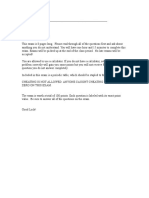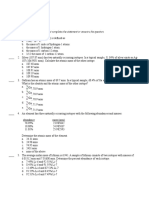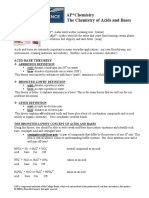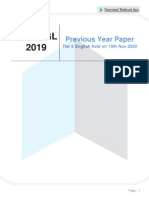Limiting Reactants
Uploaded by
api-182809945Limiting Reactants
Uploaded by
api-182809945Limiting Reactants
Why?
Reactants are not always present in the exact amounts required by the balanced
chemical reaction equation. In planning any cost-effective production process, it is
necessary to recognize which component limits the amount of material that can be
produced. Identifying the limiting reactant in a chemical reaction will strengthen
your skills in dealing with moles, solution concentrations, and reaction
stoichiometry.
Learning Objectives
Determine the amounts of material involved in a reaction.
Identify reactants that limit the extent of a reaction and the amount of
product produced.
Success Criteria
Quick identification of the limiting and excess reactants.
Accuracy of calculations of the amounts of material reacting and being
produced in chemical reactions.
Resources
Olmsted and Williams (Chemistry 3/e, Wiley, 2002) pp. 148-154.
Prerequisites
moles, chemical compounds, chemical reaction equations, determination of
chemical formulas
New Concepts
limiting reactant, excess reactant
Vocabulary
stoichiometry
Definitions
In your own words, write definitions of the terms in the New Concepts and
Vocabulary sections.
Limiting Reactants
Model 1: Limiting Ingredient
A cake recipe calls for
2 cups of water
4 cups of flour
8 squares of chocolate
4 cups of sugar
8 oz of butter
4 eggs
Ingredients on hand
lots of water
5 cups flour
4 cups sugar
12 squares chocolate
16 oz butter
6 eggs
Limiting Reagents
Key Questions
1. According to Model 1, how much of each ingredient is necessary to make a cake?
water
flour
chocolate
sugar
butter
eggs
2. If you follow the recipe, using only the ingredients on hand in the model, how
much of each ingredient will be left over after you have baked the cake?
water
flour
chocolate
sugar
butter
eggs
3. Which of the ingredients on hand were in excess for the recipe?
4. Which of the ingredients on hand were consumed completely in making the cake?
5. Which of the ingredients limit or prevent you from making a second cake?
6. What would be a good definition for the term limiting ingredient?
7. What would be a good procedure or methodology to use for identifying the
limiting component in some manufacturing process? Test your methodology by
applying it to the following exercises.
Limiting Reactants
Exercises
1. You want to make 10 dozen standard-size cookies as specified by a recipe that
requires 16 oz of butter, 4 eggs, 3 cups of flour, and 4 cups of sugar.
In taking inventory of your supplies, you find that you have 16 oz of butter,
6 eggs, and 3 cups each of flour and sugar.
(a) Which ingredient will limit the number of cookies you can make?
(b) How many standard-size cookies can you make?
2. You have 100 bolts, 150 nuts, and 150 washers. You assemble a nut/bolt/washer
set using the following recipe or equation.
2 washers + 1 bolt + 1 nut = 1 set
(a) How many sets can you assemble from your supply?
(b) Which is the limiting component?
3. This reaction of hydrogen with oxygen to produce water is described by the
following recipe or reaction equation, which says that 2 molecules of hydrogen
react with 1 molecule of oxygen to produce 2 molecules of water.
2H2 + O2 = 2H2O
You react 150 H2 molecules with 100 O2 molecules to produce H2O. Which is the
limiting reactant, hydrogen or oxygen? How many water molecules can you
produce from your supply of hydrogen and oxygen?
Limiting Reagents
Model 2: Limiting Reactant in Moles
The reaction equation can be interpreted in terms of the number of molecules
(see Problem 3 above) or moles reacting (2 moles of hydrogen react with 1 mole of
oxygen to produce 2 moles of water). The only difference is that a mole can be
divided into fractions of a mole, a molecule cannot be divided. Each square below
represents one mole of hydrogen, oxygen, and water.
1 mole of H2
1 mole of O2
1 mole of H2O
When these react according to the reaction equation,
2H2 + O2 = 2H2O,
twice as much hydrogen will be used and twice as much water will be produced
when compared to the amount of oxygen that reacts. The diagram below indicates
what happens when 1 mole of hydrogen and 1 mole of oxygen are mixed together
and react to produce water.
Thinking in terms of moles, we could write the reaction equation as
H2 + 1/2 O2 = H2O.
Key Questions
8. How many moles of hydrogen reacted in the above diagram?
9. How many moles of oxygen remained after the reaction?
10. Was hydrogen or oxygen the limiting reactant?
Limiting Reactants
Exercises
4. If 6 moles of hydrogen (H2) and 4 moles of oxygen (O2) are mixed and reacted,
which is the limiting reactant? How many moles of water would be produced?
5. If you had 1.73 moles of hydrogen (H2) and 0.89 moles of oxygen (O2), which is the
limiting reactant? How many moles of water can you produce from your supply of
hydrogen and oxygen?
6. If you had 17.3 g of hydrogen and 8.91 g of oxygen, which is the limiting reactant,
and how many grams of water could you produce?
Problems
1. Cisplatin is an antitumor agent. It has the molecular formula Pt(NH3)2Cl2. How
many grams of cisplatin can be produced if the limiting reactant is 1 kg of
platinum?
2. Hydrogen cyanide is used in the production of cyanimid fertilizers. It is produced
by the following reaction. (a) How much hydrogen cyanide can be produced
starting with 100 kg of each of the reactants? (b) Which is the limiting reactant?
2 CH4 + 2 NH3 + 3 O2 2 HCN + 6 H2O
You might also like
- ESHIA For GHANA OCTP BLOCK Phase 1 Final Volume 1 Report - vlt22952No ratings yetESHIA For GHANA OCTP BLOCK Phase 1 Final Volume 1 Report - vlt22952280 pages
- Chapter 3 - Calculations With Chemical FormulasNo ratings yetChapter 3 - Calculations With Chemical Formulas24 pages
- CHE1031 Exam 2: Moles Through Stoichiometry & Quantitative Analysis KEYNo ratings yetCHE1031 Exam 2: Moles Through Stoichiometry & Quantitative Analysis KEY5 pages
- Q4.2.Spontaneous Processes Entropy Free EnergyNo ratings yetQ4.2.Spontaneous Processes Entropy Free Energy60 pages
- The Learners Demonstrate An Understanding ofNo ratings yetThe Learners Demonstrate An Understanding of3 pages
- Doodle World Wildlife Day | by SlidesgoNo ratings yetDoodle World Wildlife Day | by Slidesgo52 pages
- Atoms, Molecules, and Ions: © 2015 Pearson Education, IncNo ratings yetAtoms, Molecules, and Ions: © 2015 Pearson Education, Inc76 pages
- Extra Practice - Stoichiometry Answers PDFNo ratings yetExtra Practice - Stoichiometry Answers PDF2 pages
- Earth Science SHS 15.1 How Layers of Rocks Are FormedNo ratings yetEarth Science SHS 15.1 How Layers of Rocks Are Formed33 pages
- Methods of Expression-Compositions of Mixtures and Solutions100% (1)Methods of Expression-Compositions of Mixtures and Solutions23 pages
- Chem - Limiting Reactant and Percent YieldNo ratings yetChem - Limiting Reactant and Percent Yield19 pages
- Quarter 1-Examination-EARTH and LIFE SCIENCE-with KeyNo ratings yetQuarter 1-Examination-EARTH and LIFE SCIENCE-with Key4 pages
- Solution and Concentration: Sku1013 Basic Chemistry 1No ratings yetSolution and Concentration: Sku1013 Basic Chemistry 153 pages
- 03 Solubility Study Guide - Multiple ChoiceNo ratings yet03 Solubility Study Guide - Multiple Choice24 pages
- Science, Technology, Engineering and Mathematics (Stem) : Vapn Condn Fusion FreezingNo ratings yetScience, Technology, Engineering and Mathematics (Stem) : Vapn Condn Fusion Freezing3 pages
- Chemistry Level M Couse Question Document PDFNo ratings yetChemistry Level M Couse Question Document PDF46 pages
- Counting Atoms Balancing Equations Law of Conservation of Mass Physical Science ABM-12No ratings yetCounting Atoms Balancing Equations Law of Conservation of Mass Physical Science ABM-1210 pages
- CH 3. Mass Relations in Chemistry - StoichiometryNo ratings yetCH 3. Mass Relations in Chemistry - Stoichiometry12 pages
- 03 ABM 12 PASAY Physical Science S2 Q1 W6No ratings yet03 ABM 12 PASAY Physical Science S2 Q1 W620 pages
- Warm Up! Answer One of These 4 QuestionsNo ratings yetWarm Up! Answer One of These 4 Questions14 pages
- AP Chemistry Problem Set 9.2 Questions: AnswersNo ratings yetAP Chemistry Problem Set 9.2 Questions: Answers2 pages
- There Are in Your Body.: Over 600 MusclesNo ratings yetThere Are in Your Body.: Over 600 Muscles14 pages
- Reale Et Al. 2007. Integrating Animal Temperament Within Ecology and Evolution. Biological ReviewsNo ratings yetReale Et Al. 2007. Integrating Animal Temperament Within Ecology and Evolution. Biological Reviews28 pages
- Effects of Fire On Cultural Resources and Archeology100% (1)Effects of Fire On Cultural Resources and Archeology236 pages
- KEPADATAN POPULASI SIPUT SEMAK Elaphroconcha Planior PADA TANAMAN KUBIS TELUR Brasssica Oleracea L DI NAGARI AIE BATUMBUAK KECAMATAN GUNUNG TALANG KABUPATEN SOLOKNo ratings yetKEPADATAN POPULASI SIPUT SEMAK Elaphroconcha Planior PADA TANAMAN KUBIS TELUR Brasssica Oleracea L DI NAGARI AIE BATUMBUAK KECAMATAN GUNUNG TALANG KABUPATEN SOLOK6 pages
- Laboratory+Practice+in+Molecular+Biology+and+Diagnostics 2No ratings yetLaboratory+Practice+in+Molecular+Biology+and+Diagnostics 23 pages
- Instant download Arabidopsis Protocols 3rd Edition Luz Rivero pdf all chapter100% (6)Instant download Arabidopsis Protocols 3rd Edition Luz Rivero pdf all chapter59 pages
- Viral Concentration Determination Through Plaque Assays - Using Traditional and Novel Overlay SystemsNo ratings yetViral Concentration Determination Through Plaque Assays - Using Traditional and Novel Overlay Systems19 pages
- An Overview of Different Types and Potential of Bio-Based Adhesives Used For Wood ProductsNo ratings yetAn Overview of Different Types and Potential of Bio-Based Adhesives Used For Wood Products12 pages
- SSC CGL 2019 Tier 2 English 15th Nov 2020 c5b0bd4d 4ada076aNo ratings yetSSC CGL 2019 Tier 2 English 15th Nov 2020 c5b0bd4d 4ada076a82 pages
- ESHIA For GHANA OCTP BLOCK Phase 1 Final Volume 1 Report - vlt22952ESHIA For GHANA OCTP BLOCK Phase 1 Final Volume 1 Report - vlt22952
- CHE1031 Exam 2: Moles Through Stoichiometry & Quantitative Analysis KEYCHE1031 Exam 2: Moles Through Stoichiometry & Quantitative Analysis KEY
- Atoms, Molecules, and Ions: © 2015 Pearson Education, IncAtoms, Molecules, and Ions: © 2015 Pearson Education, Inc
- Earth Science SHS 15.1 How Layers of Rocks Are FormedEarth Science SHS 15.1 How Layers of Rocks Are Formed
- Methods of Expression-Compositions of Mixtures and SolutionsMethods of Expression-Compositions of Mixtures and Solutions
- Quarter 1-Examination-EARTH and LIFE SCIENCE-with KeyQuarter 1-Examination-EARTH and LIFE SCIENCE-with Key
- Solution and Concentration: Sku1013 Basic Chemistry 1Solution and Concentration: Sku1013 Basic Chemistry 1
- Science, Technology, Engineering and Mathematics (Stem) : Vapn Condn Fusion FreezingScience, Technology, Engineering and Mathematics (Stem) : Vapn Condn Fusion Freezing
- Counting Atoms Balancing Equations Law of Conservation of Mass Physical Science ABM-12Counting Atoms Balancing Equations Law of Conservation of Mass Physical Science ABM-12
- Reale Et Al. 2007. Integrating Animal Temperament Within Ecology and Evolution. Biological ReviewsReale Et Al. 2007. Integrating Animal Temperament Within Ecology and Evolution. Biological Reviews
- Effects of Fire On Cultural Resources and ArcheologyEffects of Fire On Cultural Resources and Archeology
- KEPADATAN POPULASI SIPUT SEMAK Elaphroconcha Planior PADA TANAMAN KUBIS TELUR Brasssica Oleracea L DI NAGARI AIE BATUMBUAK KECAMATAN GUNUNG TALANG KABUPATEN SOLOKKEPADATAN POPULASI SIPUT SEMAK Elaphroconcha Planior PADA TANAMAN KUBIS TELUR Brasssica Oleracea L DI NAGARI AIE BATUMBUAK KECAMATAN GUNUNG TALANG KABUPATEN SOLOK
- Laboratory+Practice+in+Molecular+Biology+and+Diagnostics 2Laboratory+Practice+in+Molecular+Biology+and+Diagnostics 2
- Instant download Arabidopsis Protocols 3rd Edition Luz Rivero pdf all chapterInstant download Arabidopsis Protocols 3rd Edition Luz Rivero pdf all chapter
- Viral Concentration Determination Through Plaque Assays - Using Traditional and Novel Overlay SystemsViral Concentration Determination Through Plaque Assays - Using Traditional and Novel Overlay Systems
- An Overview of Different Types and Potential of Bio-Based Adhesives Used For Wood ProductsAn Overview of Different Types and Potential of Bio-Based Adhesives Used For Wood Products
- SSC CGL 2019 Tier 2 English 15th Nov 2020 c5b0bd4d 4ada076aSSC CGL 2019 Tier 2 English 15th Nov 2020 c5b0bd4d 4ada076a

















































































































